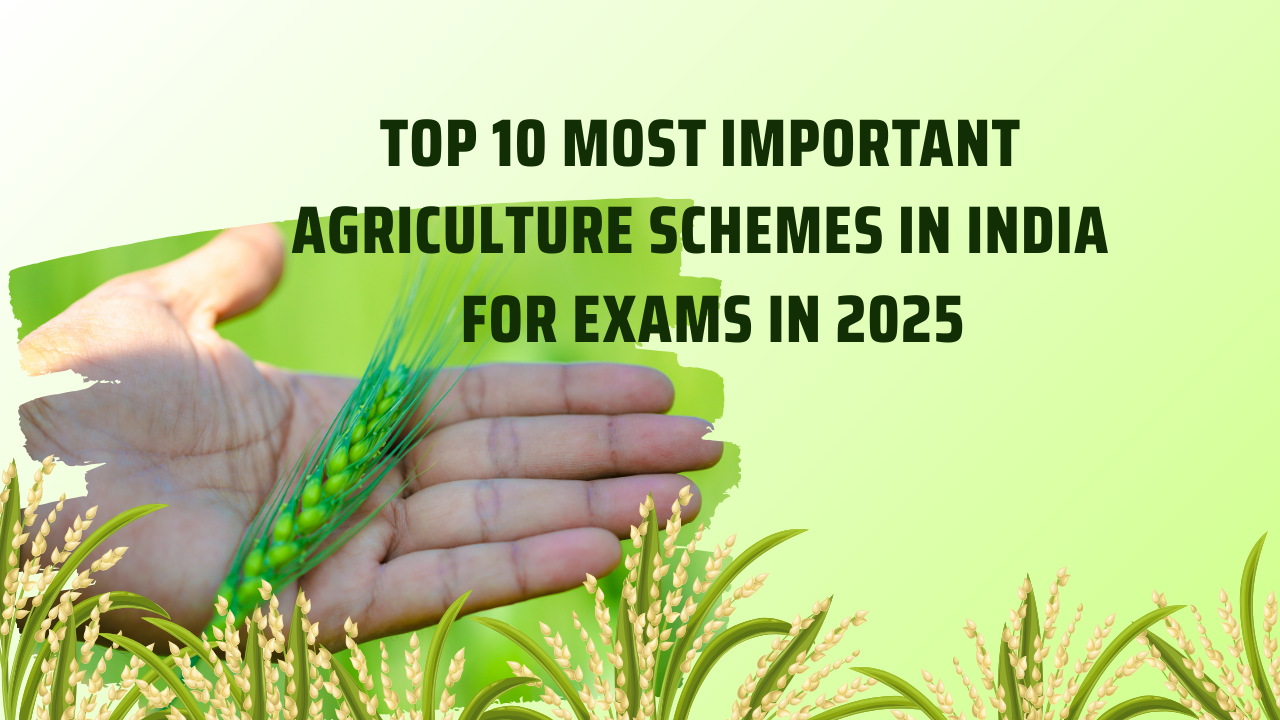Preparing for competitive exams like UPSC (Agriculture), IBPS AFO and other agriculture-related exams? Understanding key government schemes for agriculture UPSC is crucial for success. Here’s a comprehensive list of the top 10 agriculture schemes, you must know for exams in 2025.
Pradhan Mantri Krishi Sinchayee Yojana (PMKSY)
- Launched: 2015
- Objective: To ensure irrigation facilities for every farm by promoting efficient water use.
- Key Features: Focus on “Har Khet Ko Pani” and improved water efficiency through “More Crop Per Drop”.
- Sub-schemes: PMKSY includes Accelerated Irrigation Benefit Programme (AIBP), Har Khet Ko Pani, Watershed Development and Per Drop More Crop.
- Impact: Enhanced irrigation facilities have improved crop productivity across dry regions, ensuring better income for farmers.
- Relevance: A vital scheme under Pradhan Mantri Krishi Sinchai Yojana UPSC.
Rashtriya Krishi Vikas Yojana (RKVY)
- Launched: 2007
- Objective: To encourage states to increase public investment in agriculture.
- Key Features: Supports innovative ideas in agriculture, agri-tech and value chain development.
- Sub-Schemes: Includes projects like Innovations in Technology Development and Agri-Infrastructure Development.
- Impact: RKVY has been instrumental in improving rural economies and adopting innovative practices in farming.
National Mission for Sustainable Agriculture (NMSA)
- Launched: Under the National Action Plan on Climate Change (NAPCC)
- Objective: To promote sustainable agricultural practices to mitigate climate change impacts.
- Focus Areas: Water efficiency, soil health management and agroforestry.
- Key Features: Emphasizes organic farming techniques, climate-resilient seeds and promoting integrated farming systems.
- Impact: Helps farmers adopt climate-smart technologies and ensures food security.
Soil Health Card Scheme
- Launched: 2015
- Objective: To provide farmers with detailed information about their soil quality for better crop management.
- Key Features: Promotes balanced fertilization for improved yields.
- Process: Farmers receive a soil health card every two years with recommendations for appropriate fertilizers and micronutrients.
- Impact: This scheme has enhanced crop productivity and improved soil health significantly.
Pradhan Mantri Fasal Bima Yojana (PMFBY)
- Launched: 2016
- Objective: To provide affordable crop insurance and ensure financial stability for farmers.
- Key Features: Offers low premium rates, faster claim settlements and covers post-harvest losses.
- Impact: Over 30 million farmers have benefited annually, reducing their financial risks.
Kisan Credit Card (KCC) Scheme
- Launched: 1998
- Objective: To provide timely credit to farmers for agriculture needs.
- Key Features: Flexible repayment options, low interest rates and working capital for crop production.
- Impact: The scheme has provided small and marginal farmers with essential financial support for seeds, fertilizers and equipment.
National Agriculture Market (e-NAM)
- Launched: 2016
- Objective: To create a unified national market for agricultural commodities.
- Key Features: Provides real-time price discovery, ensures transparency and reduces exploitation by middlemen.
- Process: Farmers can sell their produce online across different mandis, improving access to better prices.
- Impact: e-NAM has significantly improved market linkages and farmers’ earnings.
Paramparagat Krishi Vikas Yojana (PKVY)
- Launched: 2015
- Objective: To promote organic farming through cluster-based cultivation.
- Key Features: Encourages natural fertilizers, bio-pesticides and reduces chemical inputs.
- Process: Farmer clusters are created, each comprising 20 hectares, to ensure collective adoption of organic practices.
- Impact: This scheme has enhanced soil fertility, improved farm incomes and promoted sustainable agriculture.
Mahatma Gandhi National Rural Employment Guarantee Act (MGNREGA) – Agricultural Focus
- Launched: 2005
- Objective: To provide guaranteed rural employment, including agriculture-related activities like irrigation, soil conservation and afforestation.
- Key Features: Ensures 100 days of wage employment for rural households, with provisions for creating productive assets.
- Impact: Improved rural livelihoods and strengthened agricultural infrastructure.
Integrated Scheme on Agricultural Marketing (ISAM)
- Launched: 2014
- Objective: To strengthen marketing infrastructure and improve value chain management for farmers.
- Key Features: Includes initiatives like Agri-Tech Infrastructure Fund and Market Research & Information Network.
- Impact: Farmers have gained better price realization and reduced post-harvest losses.
Why Are These Schemes Important for Exams in 2025?
Competitive exams like UPSC, IBPS AFO and State Agriculture Exams often emphasize these schemes in both prelims and mains. Candidates must understand their objectives, key features and impacts to answer MCQs, descriptive questions and interview queries effectively.
How to Prepare for Agriculture Schemes in Exams?
- Create Summary Notes: Write concise notes highlighting each scheme’s launch year, objectives and key features.
- Link with Current Affairs: Understand how these schemes are integrated into recent policies or initiatives.
- Focus on Budget Allocations: Exam papers often emphasize financial allocations and recent updates.
- Practice Mock Tests: Regularly attempt MCQs based on agriculture schemes to improve recall.
Final Tip for Aspirants
To master agriculture schemes for AFO and other exams, create concise notes, link schemes to current events and practice mock tests for better retention. Stay updated with recent amendments or changes in these schemes for exam success.
For expert guidance on agriculture exam preparation, visit Agri Coaching Chandigarh today. Stay tuned to Agri Coaching Chandigarh’s blogs for more informative posts like this.






